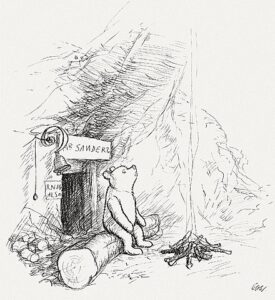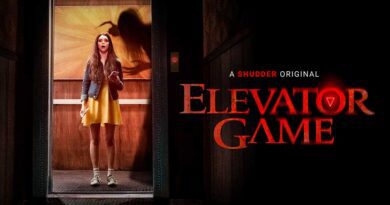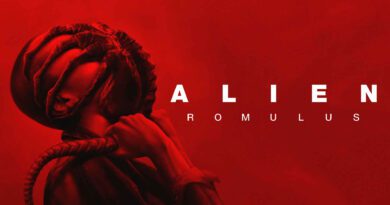Winnie The Pooh: Blood And Honey Kills Our Childhood
You can’t refer to a horror movie like “Winnie the Pooh: Blood and Honey” without introducing the importance of this children’s classic. Each of us has the contents he grew up with. The Winnie Pooh franchise, adapted into several movies and series by Walt Disney, may be very high on my list. What is more, there is no doubt that they are still relevant. As a family with two daughters, we keep several books from the Winnie the Pooh series on our bookshelf, play board games with our favorite characters, and occasionally watch content on TV or Youtube.
In recent years, we have seen several films that refer to the mythology surrounding the most famous teddy bear in the world. For example, we got to know the life of the writer Alan Alexander (A.A) Milne and his family members, especially Christopher Robin (“Goodbye Christopher Robin,” 2017). In the live-action film from 2018, “Christopher Robin” starring Ewan McGregor, we learn How the lively and imaginative boy turned into a gray businessman until the whole gang – you know, Winnie the Pooh, Piglet, Eeyore, Owl, Rabbit, Tigger, Donkey and the rest of the animals from Hacker’s Forest – came in and repainted them in all the colors of the rainbow. Where does “Winnie the Pooh: Blood and Honey,” intended for adults only, enter the story?
“Winnie the Pooh: Blood and Honey”: Like The Book, But Bloodier
Let’s start at the beginning. “Winnie the Pooh: Blood and Honey” (not to be confused with “In the Land of Blood and Honey,” Angelina Jolie’s directorial debut) is an British independant slasher written, directed and produced by Rhys Frake-Waterfield. The movie presents a question no one ever asked as a child: What would happen if Winnie the Pooh and Piglet became serial killers? We have to mention, in case you tought differently, that it is NOT a horror movie for children.
The background to this surprising process is described in a short – and relatively successful – animated video opening the film. The animation presents a plot similar to the movie “Winnie the Pooh: The Greatest Adventure” with a bloody twist. In “Blood And Honey,” no one takes care of his former friends when the young Christopher Robin leaves the hundred acres forest to attend college. Winter is coming, and the food is running out. At first, they eat poor Eeyore. Later, they attack humans. When Christopher Robin returns to the forest to introduce his former friends to his future wife (mainly so you don’t think he’s crazy and break up with him), they discover the truth about w his past friends. We get some of the ridiculous lines heard on the movie screen (“Pooh, you’ve got to help me. There’s something wrong with a piglet. He killed my wife”), and the movie rolls on.
In the following scenes, we meet a group of girls who go to stay in a cabin located in the heart of one hundred acres forest, after one of them has had an experience involving a male stalker. Anyway, very quickly, Pooh and Piglet discover that there is easy prey here. Without making spoilers (mainly because there isn’t a coherent plot here), at some point, the girls will be brutally murdered, and those who aren’t – will join something like a couple of scenes for Christopher Robin’s survival journey. Then we get a brutally pathos-filled scene where one of the characters mourns the death of someone she knew just two minutes ago in an exaggerated way we’d expect to see in a soap opera after 4,400 episodes together. In the final scene, one of the characters apparently decides she has something else to do, leaves the frame, and the movie ends, somewhat surprisingly. Of course, a sequel has already been announced, not surprisingly: this film did quite well concerning the budget. It grossed about $4 million for a budget of about $100,000, far more than a film of its caliber deserves.
Anyway, to get you in line, here is the”Winnie the Pooh: Blood and Honey” trailer:
The Good News: You Can Make A Movie About Winnie The Pooh. Kind Of
To understand why “Winnie the Pooh: Blood and Honey” looks and feels the way it does, you need to understand what happened earlier. In the United States, as far as we know, the copyright on a book expires after 95 years. This means that starting from January 2022, the rights to the original book, written by A.A Milne and illustrated by E.H Shepard, have moved into the public domain. Therefore, it is possible to adapt the book and use the characters in it without the need for permission or credit. And by the way, the rights of Tigger have yet to go into the public domain, so you didn’t see him in this movie. Lucky him.
The problem is that Walt Disney’s unique representation of these characters does own copyright since the 1966 version, and these rights will be preserved for decades to come. In other words: the production had to avoid any representation reminiscent of the characters we know from Disney movies and books, so the traditional red shirt of Winnie the Pooh, for example, cannot be considered. Instead, we got a kind of jumpsuit that was at least red.

These facts can explain part of the matter but not all of it. The film, by and large, looks like a generic slasher with two killers who simply put on their heads masks of a bear and a pig. There are cases where a human character with an animal mask can contribute to the film, for example, the creepy scenes with the wolf mask “Peachfuzz” in the “Creep” movies or the dog mask in “You’re Next.” But if you’re going to make a mask, why not one that covers the whole face so that the character doesn’t look like an actor wearing a mask carelessly so that in some scenes you see his neck and in others, don’t you? Of course, the design of the villains also raises questions. Winnie the Pooh looks more like a man in a size of Victor Crowley (from the lovable “Hatchet” movies), just wearing a brown-dyed Shrek mask.
The film raises many questions, some related to its comedic aspect but unintentionally. The creators defined it as a horror comedy, but it is neither scary nor entertaining, even as a parody. Pooh and Piglet are supposed to be something between a wild animal and a human. They look and act mostly like a human with a mask, but something is unclear about their nature: say, the swarm of bees that Poo the bear controls (bad computer animation) as if he were Candyman or his irrational power. Piglet is fond of chains; although you can find an explanation, the movie doesn’t do it. Everything seems too random. In one of the main scenes of the film, our two guys decide to drive a car on the head of an unfortunate girl, which means that there is probably someone in the forest that teaches animals to drive cars.
View this post on Instagram
The Honey Is Getting Bitter
The film was shot in Ashdown Forest in Great Britain, inspiring many of the landscapes in A.A Milne’s book. You would likely be disappointed if you were expecting authenticity or an atmosphere that would take you back to your childhood. The film was shot in only ten days, in April 2022, and as director Rhys Freak testified – to be ready as fast as possible.
The problem is that, probably for these reasons, the result is very sloppy, as if someone in the production followed the approach of striking the iron while it’s hot, eating the honey while it’s still fresh, or in short: “Leave it, bro. They won’t notice. Come on, let’s finish already; the main thing is that we have a horror movie about Winnie the Pooh.” The minimal budget is part of the issue, even tough it increased a bit after they discovered a viral interest in the film. That interest resulted in the movie being screened for more than one day, as planned First, and it also reached other countries. But it was possible to create a much more successful product here with more hard work, thought, creativity, and talent.
The first good news is that, unlike many other low-budget films, we have not been dragged into the realms of found footage, quasi-amateur photography, and the like. Some shots don’t look bad at all, the camera is stable (mostly), and there are even some solid camera movements and interesting angles. But when you focus on the frame, you realize something is wrong. The first main thing missing in the film is a sense of orientation because this is one of the messier films I remember from the last few years. While watching the movie, I figured out exactly where and when it was supposed to take place. Is it in the open forest or closed areas? Day or night? That’s how, for example, I realized that most of the events are at night because that’s what is customary in horror movies, yet it seems that they were filmed during the day because of something that looks like the sun’s rays penetrating the frame. This is especially noticeable in the awkward pool scene, but not only.
In general, the lighting work here is one of the least impressive I have seen in my life in cinema: and this does not include only thousands of films and the homework of students I watched during the first years of my undergraduate studies. The film is very dark or too bright; sometimes, you must try to understand what you see in the frame. In many scenes, something that looks like smoke or steam appears. Maybe it’s supposed to indicate cold or some supernatural activity or create a creepy atmosphere, or it’s a smoke machine someone left over from their wedding. I expected to see Pooh and Piglet going out for a slow dance, with smoke, soap bubbles, and burning torches in the background.
The feeling is that there is no skilled hand to guide the process, or if you will: someone here tried to round corners. The film is short (only about 80 minutes) but needs to be revised in pace. Some shots are too long, some too fast, and others have unclear functions. The sound editing here is also very problematic. On the positive side, there were creative attempts to do something different. According to reports, Andrew Scott Bell created music using an instrument that combines a beehive with a violin (!), a wooden hammer that hits a water bottle (!!), and other developments. These effects are kinda-cool and adds creativity to the production, so why not?
However, even with these additions the final result which is pretty strange. There are several cases where they added sound to a movie that seems to belong to another film, and sometimes the volume doesn’t match what’s happening in the scene. I swear a character in there whispered louder than she shouted.
Looking For Characters of The Characters
There is little to talk about the acting here, as it ranges from average, bad, and very bad. The truth is that some actresses tried, but there wasn’t anything to work with here. None of the characters in “Winnie the Pooh: Blood and Honey” have any depth beyond a brief characterization that can be attributed to them, which might fit their stereotypical description in a reality show, but not in a full-length film. Some girls have a name that repeats once or twice because that’s how we might remember them. One can describe other characters in one or two words: there was, for example, someone with glasses who was probably the smartest of the bunch. Another girl was busy throughout the movie taking selfies in a bikini (this is the only character in the film who had depth, but not in the emotional-mental sense), and so on.
View this post on Instagram
Even when the script tries to create something – for example, very early on, we learn that two of the girls are at the beginning of a relationship and that one of them is probably more passionate than the other – this issue is not mentioned again later in the film, and certainly does not contribute to our understanding of the characters or the way they behave. Also, the trauma of who is supposed to be the main character is pretty much abandoned after we see in the flashback what exactly happened.
Some characters are used mainly on the standard of a failed commentator in football games, who conveys to the viewer and the other characters what they see in the frame (or, in the case of sports: in the replays). For example: “He entered” when Pooh or Piglet – call me a racist, but there were times when it was a bit difficult for me to distinguish between them – entered the house, “it sounds like a piglet’s grunts” when you hear a piglet’s grunts in the background, or “she tried to shoot a gun and didn’t Succeed” when some unrelated secondary character tried to shoot a gun and didn’t succeed.
And let’s not start talking here about characters that appear and go, like one of the villain characters who just disappears towards the end: that is, they try to kill her, but then the second villain kills the person who wanted to kill the first villain, but we don’t know if the second villain died or if he survived because He has not been seen since. When I read that the director of the film explained in an interview that this character is still alive, I realized again how sloppy this film is. How and why on earth the director has to explain what the viewer is supposed to understand on their own?
So Should You Give “Winnie The Pooh: Blood And Honey” A Chance?
When the movie ended (I guess it did because there were subtitles and then a black screen), it’s hard to say that I felt cheated or disappointed. After all the reviews, low scores, and negative hype, I knew what I was getting into: A movie with a 3.5 out of 10 user rating on IMDB or 4% positive reviews on Rotten Tomatoes. I wouldn’t say you should give up the film entirely because I’m guilty of watching bad movies, and sometimes I even bizarrely enjoy them. Among all the failings, flaws, and catastrophes, there are a few decent minutes here, it offers quite a lot of gore, and the basic idea is pretty decent.
I am worried about the fairy tales and children’s books to come, which might get their horror twist. Alongside the planned sequel, which will probably include additional characters from the stories, the director has already stated that he intends to create horror versions of “Bambi” and “Peter Pan.” These horror adaptations may become more common when more classic works become public domain so that more movies will ruin our childhoods. Does anyone know when the rights of Mickey Mouse Clubhouse expire?
Some of the links on this site are affiliate links. That means if you purchase through them, we might earn a small commission. But don’t worry... it won’t cost you extra, and it probably won’t summon anything...
So if you’re thinking of buying something… don’t be afraid to click! 🔪👁️







